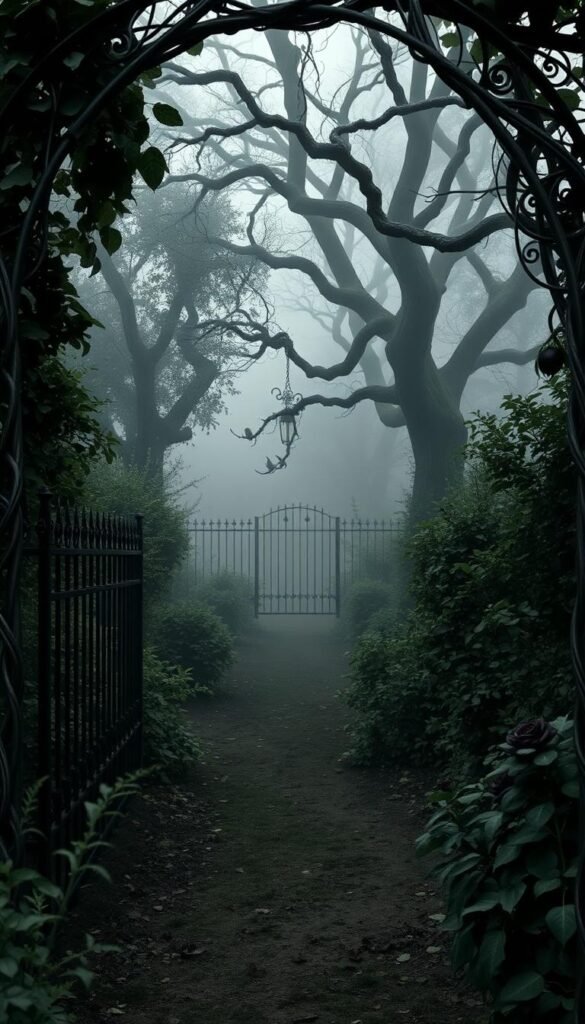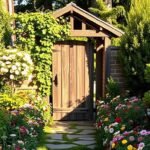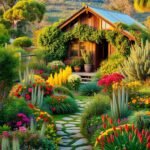Imagine stepping into a space where twilight lingers year-round. A place where deep-hued flowers whisper secrets to weathered statues, and intricate metal accents frame pathways like forgotten treasures. This is the essence of a modern goth garden – a style blending Victorian-era mystery with today’s practical needs.
These spaces aren’t just for Halloween enthusiasts. They offer a refreshing twist on traditional landscapes, using rich colors and architectural elements to create depth. You’ll find they’re surprisingly low-maintenance compared to prim flower beds, thriving with plants that love dappled sunlight.
Victorian inspiration meets contemporary ease in this approach. Think less about strict symmetry, more about creating natural-looking drama. Weathered urns paired with velvety-leaved plants achieve that “aged to perfection” look without constant upkeep.
Your journey begins with understanding how shadow play and texture interactions transform ordinary yards. From selecting midnight-blooming flowers to choosing statement-making fixtures, every detail contributes to that timeless, slightly mysterious vibe. Let’s explore how to craft an outdoor retreat that feels both enchanted and effortlessly livable.
Introduction to Your Dark Garden Journey
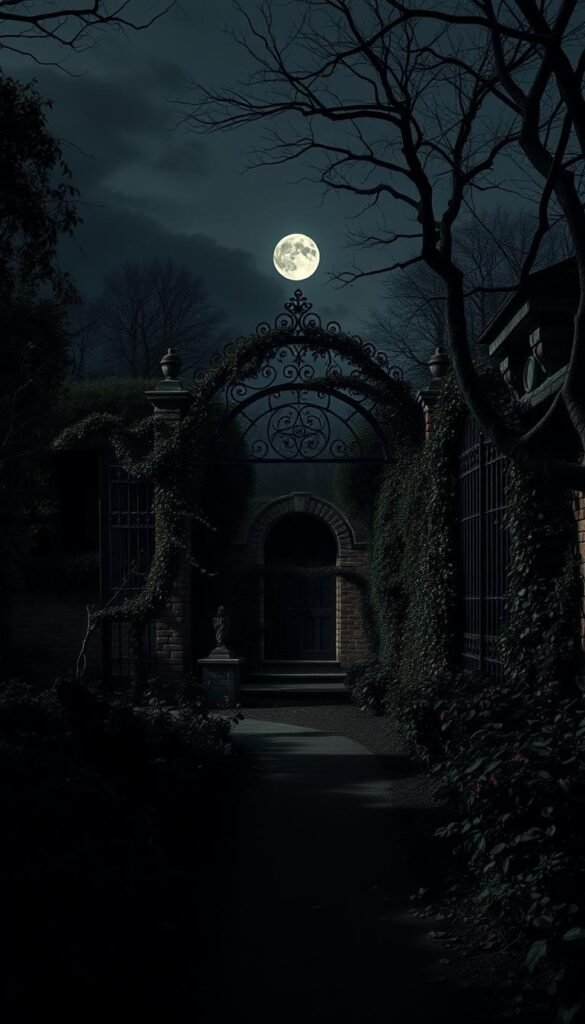
Picture a landscape where mystery grows as thick as ivy on ancient walls. Modern goth gardens borrow from Victorian novels, where every twisted vine and weathered bench hints at untold stories. These spaces thrive on contrasts – delicate textures against rugged iron, twilight hues beside deep greens.
Your outdoor sanctuary becomes a stage for atmospheric storytelling. Unlike seasonal Halloween setups, this approach focuses on enduring elegance. Think less about cobwebs, more about creating a living backdrop for quiet contemplation or moonlit gatherings.
“A garden should make you feel you’ve entered privileged space – a place not just set apart but reverberant.”
Three elements define this journey:
- Literary inspiration from 19th-century romanticism
- Practical designs that age gracefully
- Personal touches reflecting your love for intrigue
| Feature | Traditional Gardens | Goth Gardens |
|---|---|---|
| Color Palette | Bright, varied hues | Deep burgundies, purples, blacks |
| Inspiration | Formal landscapes | Victorian novels & architecture |
| Maintenance | High upkeep | Weather-friendly materials |
| Atmosphere | Cheerful | Thoughtfully mysterious |
This style suits those craving depth in their outdoor spaces. You’ll learn to balance drama with functionality, using plants and structures that whisper rather than shout. Ready to transform your yard into a chapter from your favorite eerie tale?
Key Elements of a Gothic Garden
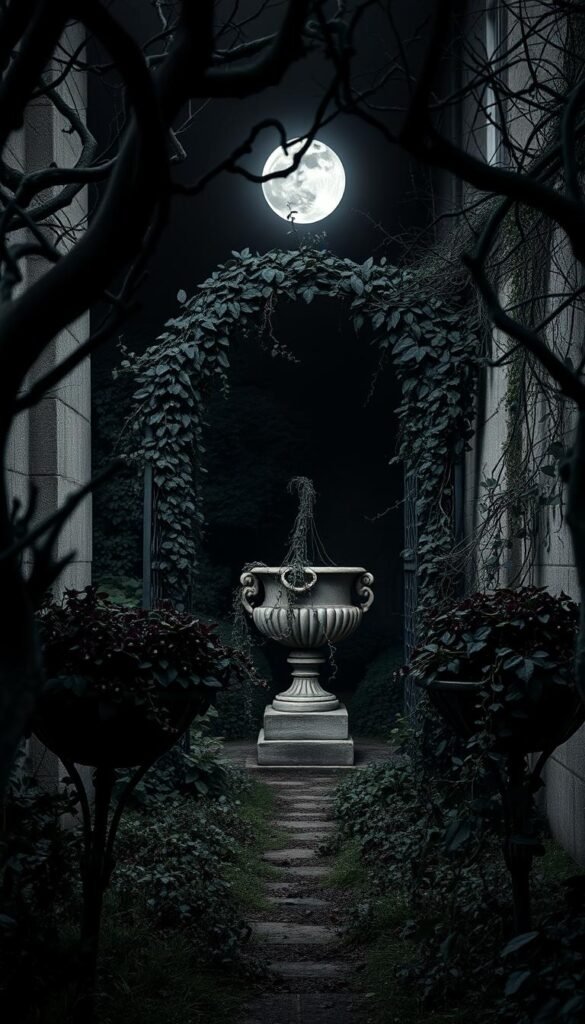
Think of your outdoor space as a living painting where every brushstroke adds drama. Two components form the backbone of this style: botanical selections that defy convention and architectural pieces whispering of bygone eras. Let’s explore what makes these elements work in harmony.
Deep-Hued Botanicals and Textured Greens
Your plant palette becomes the star with varieties that flirt with darkness. Seek out near-black cultivars – midnight petunias or tulips with velvet-like petals create instant intrigue. Irises in plum shades add depth between blooms.
Foliage plants maintain the mood year-round. Silver-leafed varieties contrast beautifully with deeper greens, while spiky succulents add unexpected texture. You’ll find these greens require less fuss than traditional flowering plants.
Timeworn Metal and Stone Accents
Wrought iron gates become functional art pieces, their scrollwork framing secret pathways. Pair them with cast-iron borders that weather beautifully over time. These structural pieces not only define spaces. They develop a sense of history that new materials can’t replicate.
Complete the look with stone troughs holding trailing ivy or moss-covered urns. Aged accessories work best when they appear discovered rather than placed. Your space gains character through these intentional imperfections.
Gothic Garden Aesthetic: Dark Blooms, Ornate Ironwork, and Shadowy Corners
Envision a canvas where shadows dance with petals of midnight. Your outdoor space transforms through three core elements: moody botanicals, aged metal accents, and clever light manipulation. These components work together to craft spaces that feel both timeless and personally expressive.
Start with near-black plants like ‘Queen of Night’ tulips or ‘Black Pearl’ ornamental peppers. Their rich tones create depth even in small spaces. Pair them with wine-colored coleus or indigo salvias for layered texture. This approach maintains visual harmony while avoiding monotony.
Metal structures serve dual purposes. Wrought-iron trellises support climbing vines while adding vertical interest. Consider arched frames for roses or weather-resistant plant stands that develop natural patina. These pieces anchor your design like punctuation marks in a poem.
| Element | Function | Seasonal Impact |
|---|---|---|
| Dark Blooms | Create focal points | Spring-Fall |
| Iron Features | Provide structure | Year-round |
| Shaded Areas | Enhance mystery | All seasons |
Strategic placement matters most. Cluster taller specimens near seating areas to filter sunlight. Let creeping thyme spill over stone edges near pathways. For those exploring structured gardening approaches, this style offers flexibility – organized enough to feel intentional, wild enough to spark curiosity.
Remember: your space should evolve like a well-loved novel. Let ivy claim part of a bench. Allow moss to soften concrete planters. These gradual changes add authentic character that can’t be rushed, proving true drama unfolds over time.
Selecting the Right Dark Flowers and Foliage
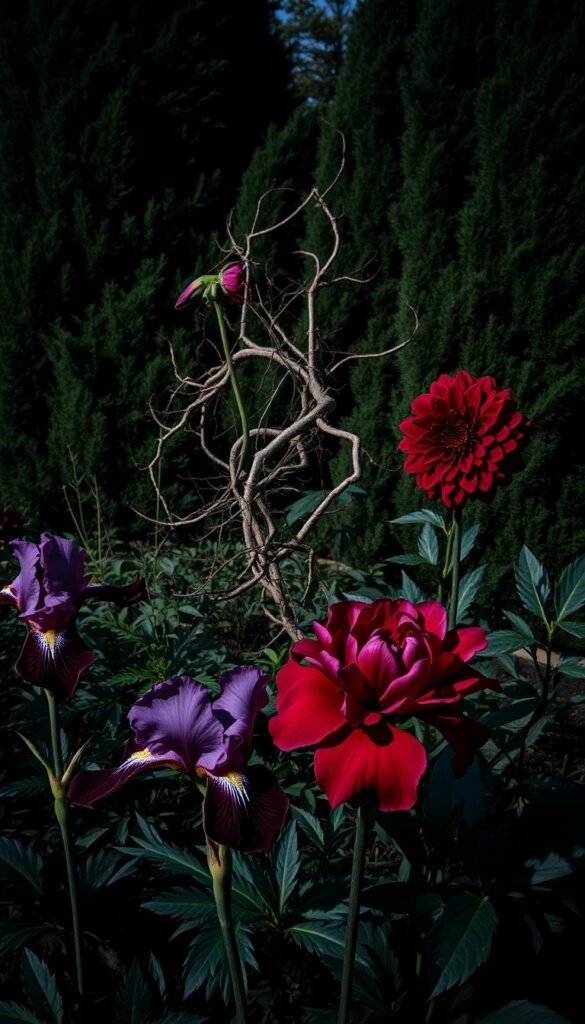
Your plant choices set the stage for a captivating outdoor space. The right combination of deep-toned botanicals creates layered intrigue while thriving in your local climate.
Night-Inspired Cultivars
Seek varieties that push color boundaries. ‘Queen of Night’ tulips unfold velvet petals in spring, while ‘Black Magic’ petunias bloom relentlessly through summer. These near-black plants work as natural focal points.
For year-round structure, consider ‘Zwartkop’ aeonium. This succulent forms striking rosettes perfect for container arrangements. Its architectural form contrasts beautifully with trailing sweet potato vines.
Rich Color Partners
Expand your palette with moody companions. Wine-colored coleus adds depth between flowering periods, while ‘Dark Side of the Moon’ astilbe brings feathery texture. These supporting players maintain visual harmony.
| Plant | Key Feature | Season |
|---|---|---|
| ‘Black Baccara’ Rose | Velvet-like blooms | Summer-Fall |
| ‘Black Pearl’ Heuchera | Crinkled leaves | Year-round |
| ‘Back in Black’ Sedum | Drought-resistant | Late Summer |
Balance bold dark flowers with practical needs. Match each plant’s light requirements to your space – some thrive in partial shade, others need morning sun. This thoughtful selection ensures your goth garden remains vibrant with minimal fuss.
Incorporating Dramatic Hardscaping and Iron Features
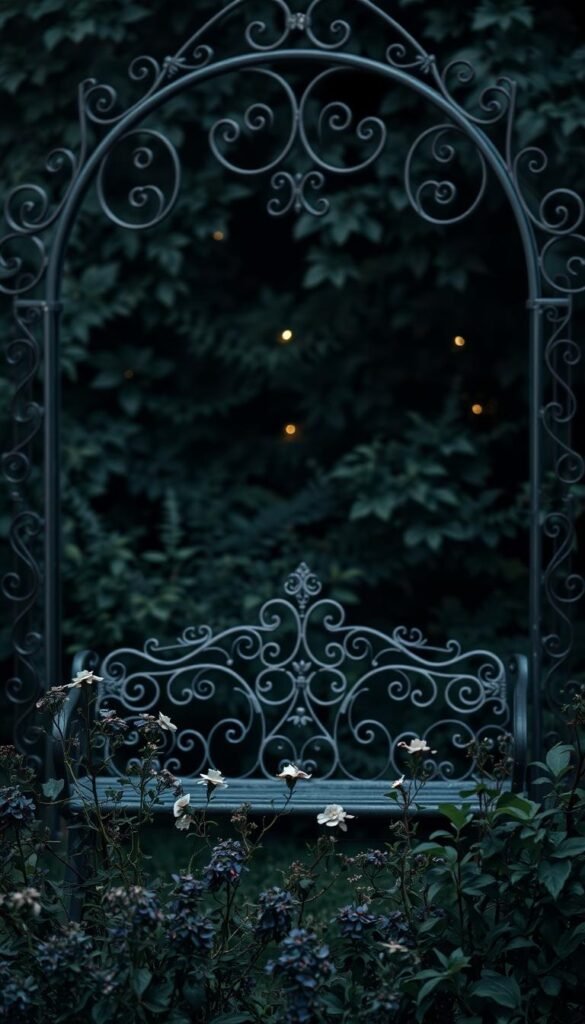
Structural elements become storytellers in your outdoor sanctuary. Thoughtful choices in materials and layout establish the gothic architecture essence while guiding movement through your space. Let’s explore how to build a framework that feels both ancient and intentional.
Wrought Iron Gates and Ornate Arches
Entryways set the tone before visitors step inside. A wrought iron gate with swirling patterns creates instant intrigue while marking transitions between areas. These pieces do double duty – supporting climbing roses or ivy while framing views of hidden nooks.
Search for arched elements that mimic cathedral designs. Repurposed stone arches from salvage yards add weathered charm instantly. Pair them with cast-iron lanterns to emphasize vertical lines after sunset.
Consider these functional accents:
- Decorative screens dividing vegetable plots from lounging areas
- Low fencing that outlines paths without blocking sightlines
- Plant stands with intricate scrollwork elevating container displays
Water features amplify the mood. A dark basin reflecting twisted branches adds movement. For authenticity, hunt estate sales for oxidized urns or cracked troughs. Their imperfections suggest decades of untold stories.
Strategic placement matters most. Position iron benches where climbing hydrangeas can eventually engulf them. Let pathways curve behind aged trellises, inviting exploration. Your design goth garden gains depth through these layered discoveries.
Creating a Spooky Ambiance with Lighting and Shadows
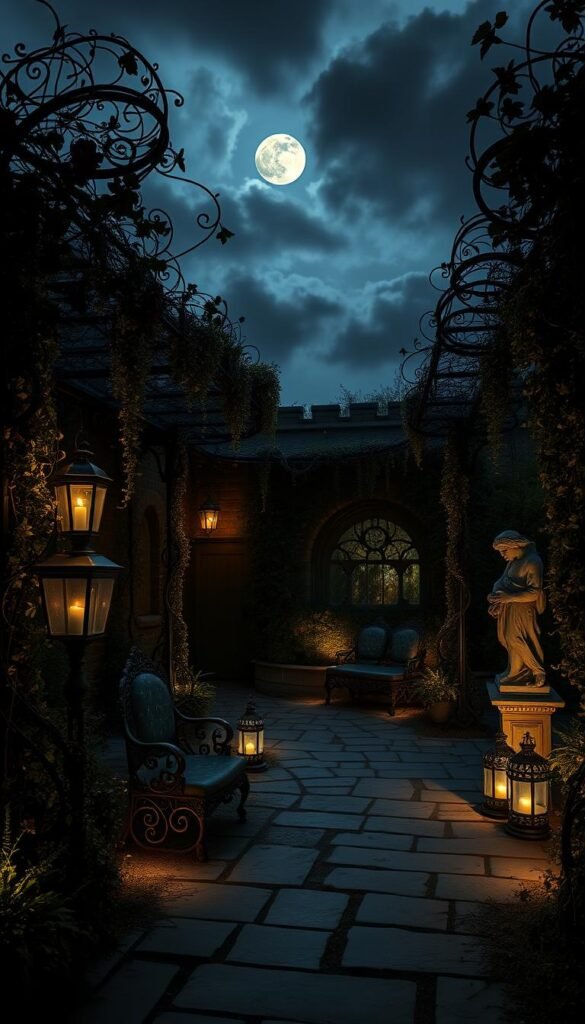
Nightfall unveils your garden’s hidden character through strategic illumination. While sunlight showcases your plants, twilight demands creative techniques to maintain intrigue. The interplay of lighting and shadows becomes a living installation, transforming paths into storybook scenes.
Victorian-Style Lamp Posts and Lanterns
Nothing captures 19th-century charm like weathered metal fixtures. A freestanding lamp post with intricate scrollwork becomes both guidepost and art piece. For smaller spaces, wall-mounted versions cast delicate patterns on nearby foliage.
Rusty cage lanterns hung from branches achieve two goals:
- Create flickering candlelit effects without fire hazards
- Project dancing silhouettes through decorative cutouts
Ambient Techniques for Nighttime Drama
Uplighting transforms trees into towering silhouettes. Position low-voltage spots at the base of trunks to emphasize textured bark. This technique works wonders with weeping varieties, their branches casting spiderweb-like patterns.
Layer illumination sources for depth:
- Path lights angled upward to graze stone walls
- Subdued spotlights highlighting statue profiles
- Solar-powered orbs nestled in shrubs for subtle glow
“Light design isn’t about brightness – it’s about directing curiosity.”
Balance safety with mystery using dimmable LEDs. Warm amber tones maintain ambiance while preventing harsh glare. Your evenings become a carefully choreographed reveal of hidden garden layers.
Innovative Container and Planter Designs for a Gothic Vibe
Your outdoor space transforms instantly when vessels become storytellers of decay and elegance. Tall urns with cracked finishes or oxidized metal planters set the scene before a single leaf unfurls. These containers work hardest when they appear discovered rather than bought new.
Hunt flea markets for weathered stone urns – their imperfections add instant character. Can’t find vintage? Transform basic pots with matte black spray paint and a dusting of bronze powder along the ridges. This creates the illusion of aged patina in minutes.
Strategic placement amplifies drama:
- Flank entryways with matching planters to frame your space
- Cluster varied heights near seating areas for layered depth
- Use elevated stands to showcase trailing specimens
The ‘thriller, filler, spiller’ design principle shines here. Pair spiky black mondo grass (thriller) with wine-colored coleus (filler). Let silver falls dichondra cascade over the edges like liquid mercury.
“Containers are the jewelry of landscape design – choose pieces that make a statement even when empty.”
These portable elements let you experiment freely. Move your goth garden accents with the seasons or rearrange them for fresh perspectives. A trio of repurposed coal buckets might hold succulents today and dried branches tomorrow, proving flexibility fuels the mysterious vibe.
Integrating Edible and Ornamental Dark Plants
Your outdoor space can nourish both body and soul when form meets function. While striking visuals matter, why not grow snacks alongside showstoppers? This approach lets you harvest ingredients while maintaining that moody charm.
Edible Options With a Twist
Black kale stands out with crinkled leaves perfect for salads or garnishes. Its deep purple veins intensify in cooler weather. Pair it with chocolate mint – a fragrant herb that thrives in partial shade and makes eerie-looking ice cubes.
Eggplant varieties like ‘Black Beauty’ add glossy foliage to beds. Their fruits work double duty in recipes and as visual anchors. For vertical interest, try purple pole beans climbing a weathered trellis.
These plants prove practicality doesn’t sacrifice style. You’ll create a goth garden that’s both feast and fantasy. Bonus: many dark-hued edibles contain higher antioxidants than their lighter cousins.
Mix them with ornamental neighbors for seamless transitions. A clump of black mondo grass might border your basil patch, while nasturtium flowers cascade over stone edges. Your space becomes deliciously unpredictable.

